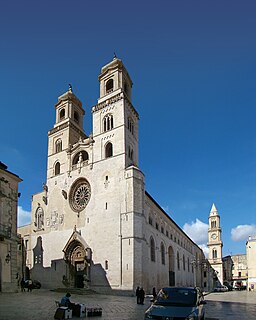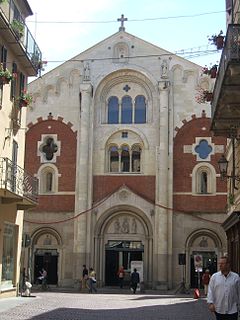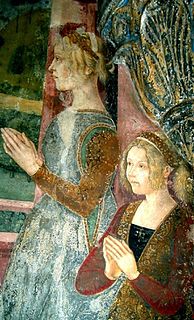Notes and references
- ↑ See Cravino (2004). (Santa Maria di Piazza, demolished in the nineteenth century, stood in what is now the eastern part of Piazza Mazzini.)
- ↑ The kinship is suggested in Liceo Scientifico Palli (n.d.), pointing to the rarity of Guala as a family name in the baptismal records in Casale.
- ↑ See Associazione Turistica Pro Loco (n.d.) for photographs and short descriptions of the churches at Frassinello.
- ↑ Cravino (2004) has a photograph of the chapel near the foot of the page.
- ↑ Cravino (2004)
- ↑ Amelotti 2003 , p. 18; Mazza (2002 , p. 9).
- ↑ Amelotti (2003 , p. 19); Grignolio (2004 , pp. 143–146); Mazza (2002 , p. 3).
- ↑ Grignolio (1983 , pp. 318–9); Legambiente (n.d.).
- ↑ See Grignolio (1983 , pp. 347–8); Comune di Livorno Ferraris (n.d.); and Cattedrale di Casale Monferrato (2006).
Related Research Articles

Livorno is a port city on the Ligurian Sea on the western coast of Tuscany, Italy. It is the capital of the Province of Livorno, having a population of 158,493 residents in December 2017. It is traditionally known in English as Leghorn.

Montferrat is part of the region of Piedmont in northern Italy. It comprises roughly the modern provinces of Alessandria and Asti. Montferrat is one of the most important wine districts of Italy. It also has a strong literary tradition, including the 18th century Asti-born poet and dramatist Vittorio Alfieri and the Alessandrian Umberto Eco.

Casale Monferrato is a town in the Piedmont region of Italy, in the province of Alessandria. It is situated about 60 km (37 mi) east of Turin on the right bank of the Po, where the river runs at the foot of the Montferrat hills. Beyond the river lies the vast plain of the Po valley.

Piazza Armerina is a comune in the province of Enna of the autonomous island region of Sicily, southern Italy.

Altamura Cathedral, dedicated to the Assumption of the Blessed Virgin Mary, is a Roman Catholic cathedral in the city of Altamura, in the Metropolitan City of Bari, Apulia, in southern Italy.

Moncalvo is a village and comune in the Province of Asti in the Italian region Piedmont, located about 45 kilometres (28 mi) east of Turin and about 15 kilometres (9 mi) northeast of Asti on the national road SS 547 which links Asti to Casale Monferrato and Vercelli. Historically it was part of the state of Montferrat and was of particular importance during the early years of the Paleologi period of the marquisate. Its best-known inhabitants were the Baroque painter Guglielmo Caccia and ‘La Bella Rosin’, King Victor Emmanuel II’s favourite mistress and eventually wife.

The Commune of Conzano is a municipality located in the south of Casale Monferrato, in the north-west of the italian province of Alessandria.
The town became famous for having been declared, in 1992, as the symbol of the massive emigration of the people to the northern Queensland, Australia, about 1890-1935 period: the ancient town square, named Piazza d'Armi, was renamed in Piazza Australia and Conzano has been twinned with Ingham, Queensland.

Melito di Napoli is a comune (municipality) in the Metropolitan City of Naples in the Italian region Campania, located about 9 kilometres (5.6 mi) north of Naples.

Saint Evasius is believed to have been a missionary and bishop of Asti, in north-west Italy. He was forced to flee to the great Padan forest known as the Selva Cornea, where he and numerous followers were beheaded by pagan, or alternatively by Arian, enemies in the area of what is now Casale Monferrato. He is venerated as a saint of the Roman Catholic Church and is the patron of a number of towns in Piedmont and Lombardy. His cult is liveliest at Casale, where his remains are conserved in the cathedral dedicated to him.

The Diocese of Casale Monferrato is a Roman Catholic diocese in northwest Italy, a suffragan of the Archdiocese of Vercelli which forms part of the ecclesiastical region of Piedmont. The diocese, which adheres to the Roman Rite, was established on 18 April 1474; in 2013 it had a population of 104,900 of whom 99,000 were baptised. In that year there was one priest for every 1,125 Catholics. Alceste Catella has been bishop of the diocese since 15 May 2008.

Pier Francesco Guala, also known as Pierfrancesco and Pietro Francesco, was an eighteenth-century Italian painter active for the most part in the region of his place of birth, Casale Monferrato.

Our Lady of Graces or Saint Mary of Graces is a devotion to the Virgin Mary in the Roman Catholic Church. Several churches with this dedication often owe their foundation to thankfulness for graces received from the Virgin Mary, and are particularly numerous in Italy, India, Australia, United States, Portugal, France and the Italian-speaking region of Switzerland. Also it is related to the Marian apparitions in which was revealed the Miraculous Medal, also known as the Medal of Our Lady of Graces.
Tommaso Audisio (1789–1845) was an Italian priest, student of architecture, and an amateur practitioner of the art.

Maestro della Cappella di Santa Margherita a Crea, or more simply Maestro di Crea, is the name given to the anonymous Italian painter who was engaged by Guglielmo VIII Paleologo, Marquis of Montferrat, to decorate the chapel of Santa Margherita in the Santuario della Madonna di Crea near Serralunga di Crea. The work was performed during the years 1474–1479. The sanctuary stands on the highest hill of the Basso Monferrato; later it would form the focal pont of the Sacro Monte di Crea.

Bologna is a station on Line B of the Rome Metro. It is an underground station located under Piazza Bologna. It was opened in December 1990. Its atrium houses mosaics from the Artemetro Roma prize, by Giuseppe Uncini and Vittorio Matino (Italy), Karl Gerstner (Switzerland) and Ulrich Erben (Germany). It was involved in the October 2005 building works for line B1, a branch line off line B.

Via di Ripetta, also called Via Ripetta, is a street in the historic centre of Rome (Italy), in the rione Campo Marzio, that links Piazza del Popolo to Via del Clementino and, with other toponyms, reaches the church of Sant'Ivo alla Sapienza, on the back of Piazza Sant'Eustachio and close to the Pantheon. It is part of the complex of streets known as Tridente.

La Storta is the 51st zona of the Italian capital city, Rome. It is identified by the initials Z. LI and falls within the boundaries of Municipio XV.

Casale Monferrato Cathedral is a Roman Catholic cathedral in Casale Monferrato, province of Alessandria, Piedmont, Italy, dedicated to Saint Evasius. It is the episcopal seat of the Diocese of Casale Monferrato.

Altamura Diocesan Museum Matroneum is a museum located inside Altamura Cathedral, whose entrance is on the left side of the church's main entrance. It is located on the second and third floors, in the so-called matroneum of Altamura Cathedral. Among other things, the museum holds statues from the Middle Ages, the XV and XVI centuries. Books, notary letters, reliquaries as well as most of the cultural heritage collected in Altamura Cathedral over the centuries are on exhibition inside the museum. The so-called Murat's cloak is also on exhibition.
References
- Amelotti, Raffaella (28 March 2003), Inquadramento paesaggistico e storico-culturale del Parco Fluviale del Po vercellese alessandrino (PDF), ENEA
- Associazione Turistica Pro Loco (n.d.), Arte, Frassinello Monferrato
- Cattedrale di Casale Monferrato (2006-11-30), Sant'Evasio, le Reliquie, la leggenda e la storia, archived from the original on 2007-04-22
- Comune di Livorno Ferraris (n.d.), Uomini Illustri
- Cravino, Mario (2004), Frassinello, ilmonferrato.info
- Grignolio, Idro (1983), Casale Monferrato, Casale Monferrato: Media editrice
- Legambiente (n.d.), "Casale Monferrato", L’Italia del Cigno
- Liceo Scientifico Palli (n.d.), Pietro Francesco Guala, Casale Monferrato, archived from the original on 2006-05-14
- Mazza, Germana, ed. (2002), Casale città aperta, Casale Monferrato: Museo Civico